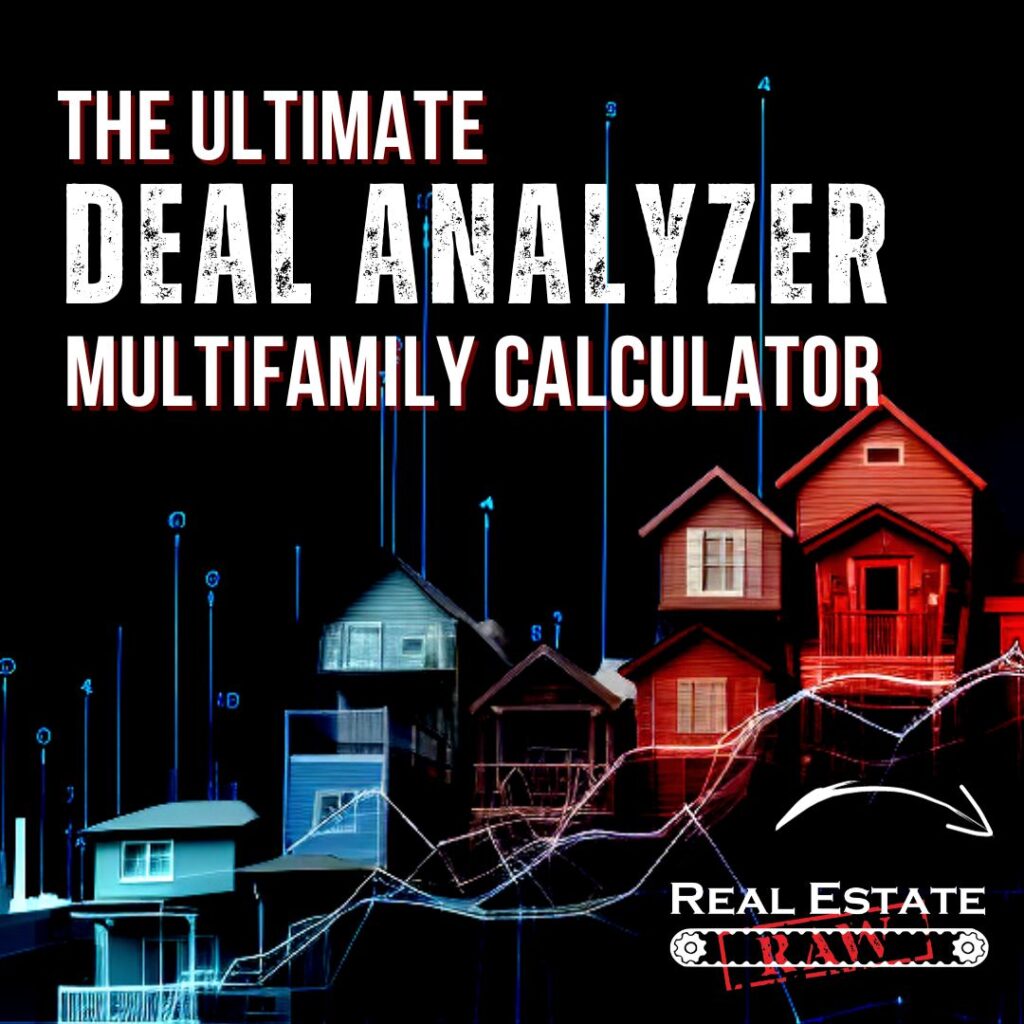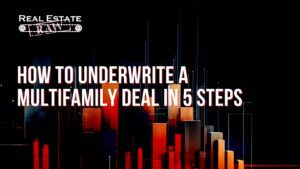How To Find Multifamily Deals
There are two basic ways to find multifamily deals. You can work with a multifamily real estate agent, or you can go directly to an owner. In this article I will cover the key aspects of how to find multifamily deals by using both methods.
Working with Multifamily Realtors
In my 20 years as an owner and operator in the multifamily business, I have found that about 80-90% of your deal flow will come from working with commercial multifamily real estate agents (realtors). The main factor in this is the size of the asset. If you are buying small multifamily properties like duplexes, and quadraplexes, you may find that contacting owners’ direct works best. Once you begin to analyze apartment complexes around 50 units or larger, most of your prospects will come from relationships with multifamily real estate agents.
Your job will be to establish relationships with the key multifamily realtors in your market. This will ultimately be done by doing property tours. I will cover this topic further in the article. For now, the next step in working with realtors will be to find out who are all the realty companies that specialize in multifamily sales in your market. This can be done by a general internet search. Once you have the list of active multifamily realty companies in your market, follow this list.
Here are step by step instructions on how to contact multifamily real estate agents.
- Go to the realty companies home website. Here are a few large national firms to start with.
- Create an account with the realty company through their homesite.
- This will likely consist of an opt-in and filling out some buyer profile questions.
- Once you have an account created with the realty company, go to the site’s current listings page.
- This is where you will find the realty companies currently listed properties.
- Select an appropriate listing and download the financial information.
- The site is likely to request that you sign a confidentiality agreement or a nondisclosure agreement.
- After you execute the agreement, download these documents-
- The offering memorandum (OM)
- The rent roll
- The financial statements (P&L) for the previous 12 months of operations (T12).
- In some cases, this information will not be available for download. In this case contact the listing agent for the information.
- Once you have the information analyze the deal.
- If you have not contacted the listing agent, do so now.
The reason I give this list in this order is for a fact that most multifamily real estate agents don’t post their multifamily properties to a multiple listing service (MLS). Some do, but most don’t. It has been my experience that you will find the occasional multifamily property ranging from 2-30 units on the MLS but once you get above 30-50 units, there are very few listings if any at all.
Multifamily realtors that specialize in multifamily will most likely have all of their listings on their company’s home websites. There are a few sites that have multifamily properties listed on them such as LoopNet and CREXI but the majority of currently listed properties will be on the realtors home site.
Another idiosyncratic aspect of multifamily realty is that the agents rarely share the commission generated by the sale with any other realtors. Most multifamily real estate agents don’t need buyers. They need sellers. This is why you need to contact the listing agent directly when wanting to view current multifamily listings. If you are using an agent to represent you (buyers’ agent) then you will want to be aware of any commission agreements or lack of.
Know What You Are Looking For
The number one mistake you can make when first reaching out to realtors is to have little understanding of what you want/can buy. You need to have a firm grasp of values in your market as well as your personal financial capabilities before you reach out to any realtor to discuss purchasing a multifamily deal.
Does this mean that you need to have cash to buy a multifamily deal?
No.
You need to have an understanding of your value and the value of your network (equity partners). This will give you an understanding of the size property that would be right for you to start with. This will allow you to communicate to the realtor what you are looking for.
The first step is to consider your borrowing capabilities. This can be done by contacting local and national lenders to discuss your borrowing options. Creative financing for multifamily is discussed below.
The second step is to decide how much multifamily real estate (in units) you can buy for the amount you can borrow plus downpayment money. How much capital you can raise/borrow will be finite in the short run but how many units you can buy will change dramatically from market to market.
Once you know what you are looking for it is time to reach out to realtors. Here are a few key points you need to have answers for before contacting realtors.
- What size property are you trying to buy?
- What is your source of funding?
- What basic returns are you looking for?
- Cash on cash (CoC)
- Internal Rate of Return (IRR)
- What capitalization rate (Cap Rate) are you looking for?
- Asset and location type
- Any age of construction requirements?
These are a few of the major talking points you will need to be ready to discuss when first contacting a multifamily real estate agent.
Here are two common ways that you can obtain multifamily real estate without lots of cash. Creative financing and syndication for multifamily.
Creative Financing for Multifamily
Creative financing is a way that you may be able to purchase (or control) a multifamily asset without having to have large sums of money to purchase the deal with. This can be by using Seller Financing or a Master Lease Option.
When first contacting realtors don’t inquire about any form of creative financing. Look at what the realtor has to offer and analyze the deal as you were going to purchase it with a traditional method (all cash or a loan). If the price does not allow the deal to fit your investment criteria, then inquire with the agent about the availability of any creative financing. If nothing is available, then thank the agent and move on to the next deal.
The realtors commission will also be a main issue for any agent involved in a creative financing offer for multifamily. How will the agent get paid?
This will need to be negotiated up front. If using seller financing, then any down payment money going to the seller could be used to pay any realtors fees.
If using a master lease option for multifamily the option money given to the seller could be used to pay the realtors fees. Another suggestion would be to make the commission payable in full when the option to purchase is executed. Sharing in the cash flow produced from the asset is also a suggestion. There are many ways to solve this problem. Work with the agent to create a solution for all parties involved.
Multifamily syndication is the process of a group of individuals combining their money to purchase a multifamily property that would otherwise be unavailable to each member of the group individually. The partnership is created to increase purchasing power through a combined net worth.
A common practice with commercial multifamily lenders such as Fannie Mae (FNMA) and Freddie Mac (FHLMC) is to require the borrower (or borrower group) to have the net worth equal to or greater than the loan amount. This is why people syndicate deals. They need the combined purchasing power of their partners (called Sponsors) to allow them to purchase larger multifamily assets.
When working with realtors it is acceptable to discuss the fact that you personally are not buying the deal alone but that you and your team will be conducting the transaction. Be ready to discuss the credibility of this team with any new realtor relationship.
How to Do a Multifamily Property Tour
Once you have analyzed the deal and made initial contact with the listing agent you will need to go to the property and meet them for a property tour. A multifamily property tour is a short inspection of the property typically consisting of a tour through one of each floor plan, any vacant units, the amenities, common areas and facilities such as laundry or exercise areas.
The multifamily property tour is not a full due diligence of the property. It is simply a sampling of the units and facilities to get a general feeling for the assets condition and location. Full due diligence will be conducted once the property is fully under a purchase and sale agreement (PSA).
The property tour typically begins by meeting the listing agent or their representative at the main office of the complex (if there is one). This will be an opportunity to meet the realtor and the property manager. This is also a good time to ask any questions that may have arisen during your underwriting process.
The manager or realtor will likely have a tour already planned as they may have had to give notice to any tenants if the tour is going to include any occupied units. If the agent does not have a tour planned here is what you will want to see.
- All vacant units unless too many to tour
- One of each floor plan on the property (i.e., 1bed, 1bath or 2bed, 1bath, etc.)
- Any amenities (pool, fitness center, etc.)
- The office area
- Any storage or maintenance area
- Walk around the property and any open spaces.
Again, this is not due diligence so keep the tour light. Don’t spend too much time in any one area. Just get feel for the asset in general.
The Follow Up
Now that you have fully analyzed (underwritten the financials) and toured the property, it is time to follow up with the agent. There is no set amount of time to wait to follow up after the tour, but I would suggest not more than a week.
Once you speak to the listing agent you will be making an offer, or you will be explaining your lack of interest in the opportunity.
Th agent will guide you through the offer process. Most commercial real estate agents will want you to make an offer by submitting a letter of intent (LOI). The LOI is a nonbinding agreement that spells out the major points of the agreement between the buyer and seller of a real estate transaction. Once the LOI is fully negotiated the buyer or seller will have a full purchase and sale agreement created from the LOI.
Tip- you are trying to buy multifamily assets that are not for sale today. If a property is for sale today, chances are that this property has been seen by the savvy investors in the market.
Your goal is to build relationships with multifamily real estate agents by doing property tours over time. At a point in the future, a new property will become available to the agent. The key is to be one of the first people the agent calls when they first get the listing. Before everyone else sees it. That’s where the best deals are found. Through relationships not sitting around on the open market.
Direct to Multifamily Owners
There are many ways to contact owners of multifamily properties. I will cover a few here but the first step is to gather the owner’s contact information. You need to build a list.
Here are a few ways to do this-
Property Tax Records: Many municipalities have online databases where you can search for property tax records. These records often include owner names and addresses.
County Assessor’s Office: Contact your local county assessor’s office for property information. Some jurisdictions provide public access to property records.
Networking: Participate in seminars, workshops, and networking events where you can meet potential sellers and people who specialize in finding and wholesaling properties.
Buy the Data: There are many data providing companies online. Research the validity of the company before purchasing any data packages. Not all list providers are created equal.
Once you have your list of owners’ contact information you will need to decide how to contact them. This can be done by many forms of communication like text, email or directly cold calling the owner.
Here are a few suggestions-
Direct Mail Campaigns: Sending targeted direct mail to property owners can be effective. Craft a compelling letter or postcard outlining your interest in purchasing their property and the benefits of working with you.
Cold Calling: Contact owners directly via phone. Prepare a script that introduces yourself, explains your interest in their property, and asks if they’re open to discuss a potential sale.
Online Research: Use public records and online platforms to find property owner information. Then, reach out via email or social media with a polite and personalized message.
Professional Letters: Send a well-crafted letter introducing yourself, your investment goals, and your interest in purchasing their property.
Once you have started to reach out to owners there will come a point where you get to speak to an owner directly. This is where you have a very short amount of time to get the seller’s attention and let them know you have a serious offer for them.
The idea when you first contact a seller is to be able to make an offer for their property “over the phone” or in the first two minutes of first speaking with them. The reason for this is to decide if this seller is interested in, (or capable) of selling the property you are calling about at a reasonable price. If not, then you don’t want to waste your time or theirs on an offer that is going nowhere.
Here is how you can make an offer on any multifamily property in under two minutes. The only information you need to have prior to the conversation is the market cap rate for similar properties in the area (or the cap rate you want to offer).
Follow this formula.
Average rent per unit on the property in question multiplied by the number of units. Multiply this number by 12 and then divide that by 2. This will give you an estimated annual net operating income (NOI) for the property.
Divide the estimated annual net operating income by the cap rate. This will give you a basic estimate of the property’s value per the market cap rate for similar assets.
Here is an example.
If a seller has a 20-unit property in which the average rent is $1,000 a month per unit per month, the average rental income for the year would be $240,000.
20 units x $1,000 a month = $20,000 a month.
$20,000 x 12 months = $240,000 annual income.
Lastly, we need to account for annual expenses. For this I am taking an industry average of 50% annual expenses. If you feel this is too high or low, adjust accordingly.
By assuming a 50% expense ratio I can keep the math simple. This is portion of the equation where I divided by 2 to get the 50% ratio.
With my estimated NOI, I can simply divide it by the market cap rate to arrive at an estimated value. This can be done in a matter of seconds with just a little bit of practice (or calculator).
The idea is to be able to make an estimated offer with our seller in the first minute or two of the first conversation so you don’t waste time and energy on sellers that cannot meet your price.
Here is a multifamily buyer and seller script.
This will illustrate this point.
Buyer- “Hello, this is Bill.”
Seller- “Hi, this is Blank the seller and you sent me letter about selling my property.”
Buyer- “Yes, thanks for calling. I can give you a general idea of what I am paying for assets like yours in that area. I just need a little bit of info.
How many units are on the property?
Seller- “20 Units”
Buyer- “Ok, and what is the average rent there?”
Seller- “About $1,000 per unit on average”.
Buyer- “Ok, give me one second to get my calculator out.”
20 units x $1000 = $20,000
$20,000 x 12 = $240,000
$240,000 / .06 = $4,000,000
(I just used a 6% cap rate here for the example)
Buyer- “Looks like I am paying between $3,800,000 and $4,200,000. Is that a price range in which you would be interested in selling the property for?”
If the seller says “No” then thank them for their time and move on to the next deal.
If the seller says “Yes” then you will need to tell them that you will need more detailed financial information from the property to give them an exact offer. This is where you ask the seller for the profit and loss for the property. With this you will be able to make an accurate offer based on the income approach to valuing multifamily real estate.
It has been my experience that if you ask a seller for their property financial information when they first contact you…it doesn’t go well. They don’t know who you are and the first thing you ask for is their financial information.
Use the script I have given you here to make an estimated offer by giving a range value not a specific offer price. This will allow you to decide if you and this seller are close enough in your opinion of the property’s value to have a chance at completing a transaction without nailing you down to a fixed price before you have any financial info on the asset.
For more information like this check out my blog at www.realestateraw.com and join my Facebook group Real Estate Raw for Multifamily Investors.
Best of luck!
Bill Ham


































